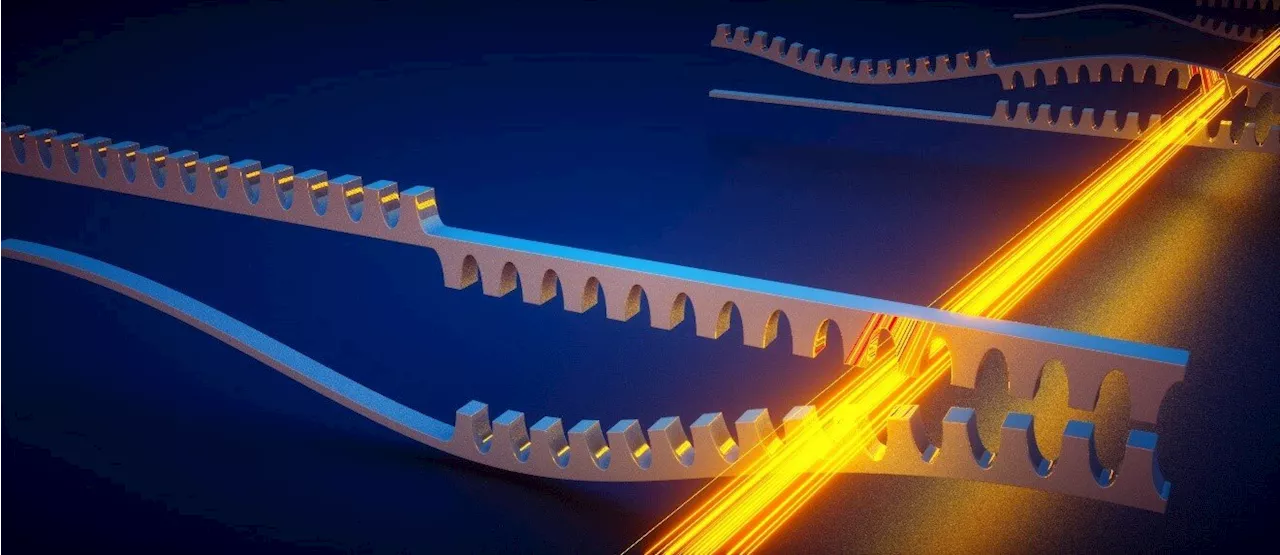Researchers at AMOLF, in collaboration with partners from Germany, Switzerland, and Austria, have realized a new type of metamaterial through which sound waves flow in an unprecedented fashion. It provides a novel form of amplification of mechanical vibrations, which has the potential to improve sensor technology and information processing devices.
New topological metamaterial amplifies sound waves exponentially retrieved 27 March 2024 from https://phys.org/news/2024-03-topological-metamaterial-amplifies-exponentially.html
This document is subject to copyright. Apart from any fair dealing for the purpose of private study or research, no part may be reproduced without the written permission. The content is provided for information purposes only.Use this form if you have come across a typo, inaccuracy or would like to send an edit request for the content on this page. For general inquiries, please use ourThank you for taking time to provide your feedback to the editors.
Your feedback is important to us. However, we do not guarantee individual replies due to the high volume of messages.to let the recipient know who sent the email. Neither your address nor the recipient's address will be used for any other purpose. The information you enter will appear in your e-mail message and is not retained by Phys.org in any form.Get weekly and/or daily updates delivered to your inbox.
United Kingdom Latest News, United Kingdom Headlines
Similar News:You can also read news stories similar to this one that we have collected from other news sources.
 Researchers develop molecules for a new class of antibiotics that can overcome drug resistant bacteriaAbout a decade ago, researchers began to observe a recurring challenge in their research: Some of the compounds they were developing to harness energy from bacteria were instead killing the microbes. Not good if the objective of the project was to harness the metabolism of living bacteria to produce electricity.
Researchers develop molecules for a new class of antibiotics that can overcome drug resistant bacteriaAbout a decade ago, researchers began to observe a recurring challenge in their research: Some of the compounds they were developing to harness energy from bacteria were instead killing the microbes. Not good if the objective of the project was to harness the metabolism of living bacteria to produce electricity.
Read more »
 Researchers invent new triple-junction tandem solar cells with world-record efficiencyScientists have developed a novel triple-junction perovskite/Si tandem solar cell that can achieve a certified world-record power conversion efficiency of 27.1 per cent across a solar energy absorption area of 1 sq cm, representing the best-performing triple-junction perovskite/Si tandem solar cell thus far.
Researchers invent new triple-junction tandem solar cells with world-record efficiencyScientists have developed a novel triple-junction perovskite/Si tandem solar cell that can achieve a certified world-record power conversion efficiency of 27.1 per cent across a solar energy absorption area of 1 sq cm, representing the best-performing triple-junction perovskite/Si tandem solar cell thus far.
Read more »
 Researchers develop new glowing touchscreen that works underwaterScientists have made a breakthrough with an ALP facilitating underwater communication. Check out how this could be a game-changer for us.
Researchers develop new glowing touchscreen that works underwaterScientists have made a breakthrough with an ALP facilitating underwater communication. Check out how this could be a game-changer for us.
Read more »
 Microplastics may be new risk factor for cardiovascular disease, researchers sayMicroplastics draw scrutiny as potential risk factor for cardiovascular disease.
Microplastics may be new risk factor for cardiovascular disease, researchers sayMicroplastics draw scrutiny as potential risk factor for cardiovascular disease.
Read more »
 Researchers open new leads in anti-HIV drug development, using a compound found in natureA team of researchers has successfully modified a naturally occurring chemical compound in the lab, resulting in advanced lead compounds with anti-HIV activity.
Researchers open new leads in anti-HIV drug development, using a compound found in natureA team of researchers has successfully modified a naturally occurring chemical compound in the lab, resulting in advanced lead compounds with anti-HIV activity.
Read more »
 Researchers devise new ways to engineer carbon-based semiconductors for electronics of the futureIt might look like a roll of chicken wire, but this tiny cylinder of carbon atoms—too small to see with the naked eye—could one day be used for making electronic devices ranging from night vision goggles and motion detectors to more efficient solar cells, thanks to techniques developed by researchers at Duke University.
Researchers devise new ways to engineer carbon-based semiconductors for electronics of the futureIt might look like a roll of chicken wire, but this tiny cylinder of carbon atoms—too small to see with the naked eye—could one day be used for making electronic devices ranging from night vision goggles and motion detectors to more efficient solar cells, thanks to techniques developed by researchers at Duke University.
Read more »
